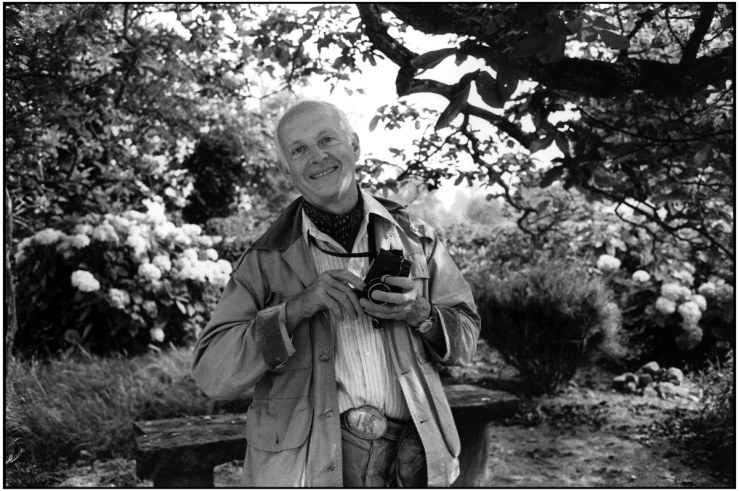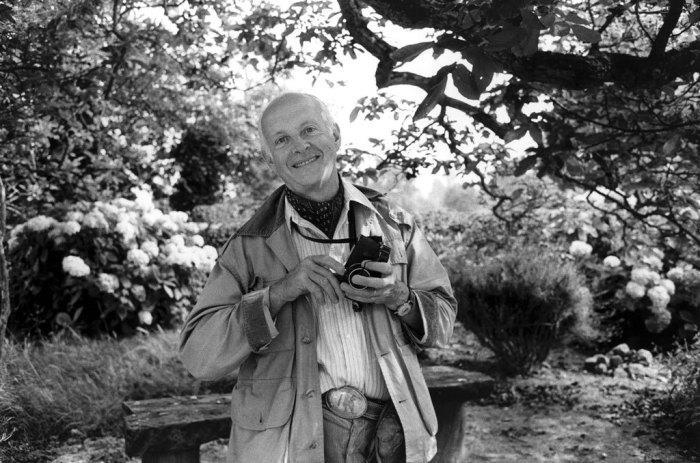
Martine Franck, fotógrafa de Magnum y la segunda esposa del fallecido gran fotógrafo Henri Cartier-Bresson, ha fallecido el pasado 17 de Agosto, a los 74 años.
En “Contact Theory”, MS. Franck recuerda haber estado en escena para tomar esta imagen memorable y cómo escogió este encuadre en particular:
“Esta foto fue tomada durante el verano de 1976. Acababa de recibir una beca de la Fondation Nationale de la Photographie… para fotografiar a los franceses en sus vacaciones. Yo estaba en mi camino para fotografiar un festival de pop y rock en Le Castellet y decidí pasar y ver a mi amigo el arquitecto Alain Capeilleres. Sabía que Alain acababa de terminar la piscina, había hablado de su concepción el año anterior y estaba muy emocionada por verla. Me saludó diciendo que un fotógrafo italiano acababa de llegar para tomar fotografías para una revisión arquitectónica y que yo debía ir a la piscina y darme un baño.
Vi a un par de personas haciendo ejercicios y una hamaca vacía y, a continuación de repente un joven se metió en la hamaca, lo primero que percibí fue la sombra y corrí. Fue todo tan rápido. Recuerdo tratar de encontrar el mejor ángulo y ser molestada por una toalla en la parte izquierda de la hamaca y un traje de baño a la derecha, entonces la esposa de Lucie Alain llegó con su sombrero, saludó al joven. Unos segundos más tarde, otro chico se subió a la hamaca. Cambié los ángulos pero la imagen ya no estaba. Tenía Tri-X en mi cámara y recuerdo claramente estar preocupada por el resplandor del sol de mediodía de agosto en los azulejos blancos. Había cerrado a f16 y estaba disparando a un 1000 de un segundo, pero sabía que todavía iban a estar sobreexpuestas, sin embargo lo más importante era que estaba convencida de que tenía una imagen.
La elección final fue fácil. La toma 18a se descartó debido a la toalla en la izquierda, las figuras del fondo estaban confundidas y había enmarcado demasiado a la sombra de la hamaca. La toma 16a era una posibilidad, pero habría tenido que recortar el traje de baño a la derecha, cosa que prefería no hacer, y el hombre haciendo flexiones en el fondo se encontraba en una posición menos interesante. La imagen que tenía la mayor intensidad y concisión para mi mente era la toma 17a.
//
Martine Franck, Magnum photographer and the second wife of the late great photographer Henri Cartier-Bresson, has passed away last August 17th, aged 74.
In “Contact Theory”, Ms. Franck remembers being en scene to take this memorable image and how she chose this particular frame:
“This picture was taken during the summer of 1976. I had just been given a grant by the Fondation Nationale de la Photographie… to photograph the French on holiday. I was on my way to photograph a pop and rock festival at Le Castellet and decided to stop by and see my friend the architect Alain Capeilleres. I knew that Alain had just completed the swimming pool, he had talked about its conception the previous year and I was really excited to see it. He greeted me by saying that an Italian photographer had just come to take photographs for an architectural review and that I should go down to the pool and have a swim.
I saw a couple of people doing exercises and an empty hammock and and then all of a sudden a young boy got into the hammock, the first thing I noticed was the shadow and I ran. It was all over so quickly. I remember trying to find the best angle and being bothered by a towel on the left of the hammock and a bathing suit on the right, then Alain’s wife Lucie arrived in her sun hat, said hello to the young boy. A few seconds later another boy climbed into the hammock. I changed angles but the picture was gone. I had Tri-X in my camera and I distinctly remember being concerned by the glare of the August midday sun on the white tilings. I had closed down to f.16 and was shooting at a 1000th of a second but I still knew I was going to be over exposed, however most important I was convinced I had an image.
The ultimate choice was easy. Frame 18a was discarded because of the towel on the left, the figures in the background were confused and I had framed too close to the shadow of the hammock. Frame 16a was a possibility but I would have had to crop the bathing suit on the right which I preferred not to do and the man doing push ups in the background was in a less interesting position. The image that had the greatest intensity and concision was to my mind frame 17a.
(via: http://iconicphotos.wordpress.com/)

Compartir esto // Share this:


















